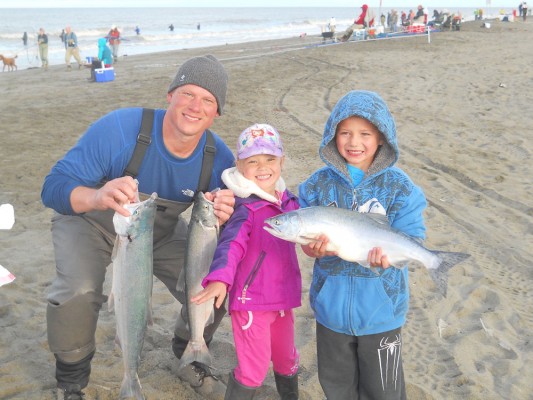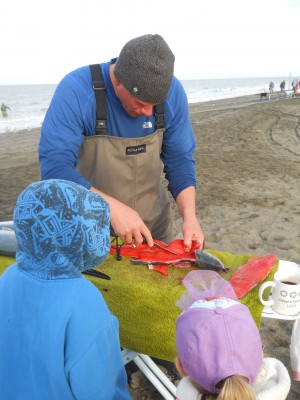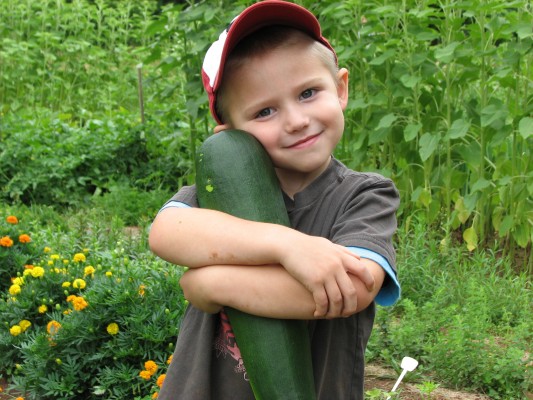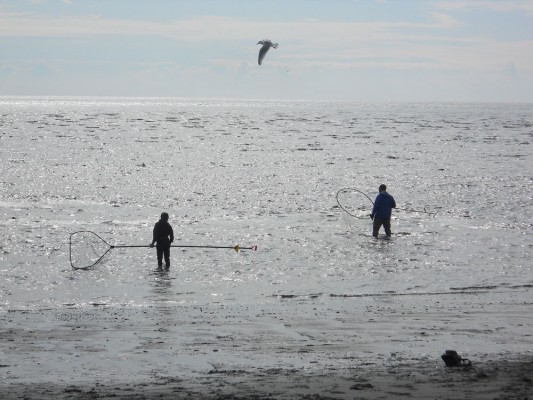When K–12 science meets Frankenfish
by Kathleen McCoy |

Mike Mueller with daughter Summer (5), and son Noah (8). He's holding sockeye salmon and Noah is holding a pink salmon the family caught while dipnetting at Kenai City Beach just north of Kenai River. (Photo provided by Mike Mueller / University of Alaska Anchorage)
Mike Mueller, a UAA professor of education who specializes in shaping how middle and high school teachers introduce their students to science, is on fire about genetically modified salmon, also known as Frankenfish.
Recently, the federal Food and Drug Administration (because genes are considered drugs) approved the very first genetically altered animal as safe to eat. Frankenfish is an Atlantic salmon with a chinook salmon growth hormone gene plus genetics from the eel-like ocean pout. This fish grows to full size in about 18 months, instead of up to four years for wild salmon.
Proponents argue that the world is hungry and this is a way to provide more food faster. Opponents fear GMO'd-salmon escapees might breed with wild salmon, introducing a "Trojan salmon" that will alter future generations and eventually lead to wild-species demise.
It's telling that by law, Frankenfish can't be farmed in the United States, but only in "land-based, contained hatchery tanks" in two specific locations, Panama and Canada. After a two-decade battle, its creator, AquaBounty Technologies, now owns a patent on the fish. Company stock climbed with the announcement.

Mueller, teaching his son Noah age 8, and daughter Summer age 5 how to work with sockeye salmon the family caught while dipnetting at Kenai City Beach just north of Kenai River. (Photo provided by Mike Mueller / University of Alaska Anchorage)
This is just the beginning of a tidal wave of complicated and important questions our kids and their kids and their kids and their kids will need to wrestle with. Mueller says the science they learn in school isn't preparing them for the task.
Take Pebble Mine versus Bristol Bay fisheries, a charged debate in Alaska. In a paper Mueller presented at the Graduate Center for the City University of New York, called, "Alaskan Salmon and Gen R: hunting, fishing to cultivate ecological mindfulness," he mentions the 30,000 pages of science delivered by Pebble Mine proponents, arguing that the headwaters of the world's largest wild salmon fishery would be safe in the face of the mining operation.
In science we trust. "We build this inherent faith in science," Mueller says. "If I just elect the right person, they will solve this climate-change problem. This is what our kids think."
Mueller, who earned his doctorate at the University of Tennessee in the philosophy of teaching and in science education, argues that the modern classroom has not kept pace with real-world challenges. Science kids learn in school is often too divorced from the world they inhabit. It's not about knowing or solving the problems they face in their own communities, but about qualifying them for a guaranteed future income.

Mueller's son Noah holds a zucchini he helped grow at the family's organic farm in Georgia. This is the kind of connection Mueller advocates for children. (Photo provided by Mike Mueller / University of Alaska Anchorage)
I am constantly pushing up against this globalizing hegemony of facts and knowledge that are not connected to children's everyday lives or anything they need to sustain themselves or nurture future generations," he says.
Specifically, Mueller is concerned about STEM (Science, Technology, Engineering and Math) and STEAM (add Arts for the A) education, often heralded as our kids' path to a secure and successful future. That's where the jobs are, right?
But STEM and STEAM are designed, Mueller says, to lead students into "careers that cultivate affluence," becoming the kind of engineers and scientists who would support a Frankenfish or a Pebble Mine if it guaranteed a middle-class lifestyle, even if an overburdened planet can no longer sustain it.
Mueller, and other eco justice-based thinkers like Chet Bowers, believe there is another, better path for science education. It's not just adding environmental studies or a green curriculum, but teaching instead relationships and interconnection. As Bowers explains it, anthropocentric thinking-humans as the most important species-has been championed at the expense of the planet, for profit and personal and corporate advancement.
But humans won't thrive alone. They depend on clean air, pollinating bumblebees and healthy plant and animal harvests. So the best thing you can do for your kids, Mueller says, and the best thing schools can do for your kids, is to send them into the backyard, into Chugach State Park, along the Chester and Campbell creeks and the Kenai River. Introduce them to what's there so they will value it and fight for it.
He encourages science teachers to take a stand on issues like Frankenfish and GMO labeling. He's already started a petition on change.org asking for GMO labeling in Alaska. Failing to take action can create a sense of powerlessness, "Like, climate change is so big, there is nothing I can do about it." That's the worst lesson you could give your kids, he says.
Mueller lives the life he champions. For two years in Georgia, he and his young family cultivated an organic farm that fed 100 families. A favorite picture shows his young son, Noah, hugging a zucchini as big as he is. He grew it; he was proud of it.

Mueller's son Riley, age 13, on the left, dipnetting with his father for sockeye salmon on the north shore of the Kenai City Beach, just north of the Kenai River. (Photo provided by Mike Mueller / University of Alaska Anchorage)
Since coming to Alaska four years ago, Mueller has expanded his subsistence skills. He's just back from a week on Adak, where he harvested two caribou. His family annually dipnets near the Kenai River. Last summer they caught 64 salmon and used some of it to barter for fresh vegetables and other goods. For two years, he's kept compost worms alive and well fed in a bin in his garage. The Mueller household thermostat is set to a cool 64 degrees.
You do what you can, he says. For those living a decidedly urban lifestyle, Mueller advises developing relationships with the people who bring you your food, through farmers' markets, CSAs, and asking for local produce in grocery stores.
"Look at the small issues that you can really have an impact on," Mueller said. "Like salmon, or hunting and fishing. Develop some mindfulness around wild creatures and animals and plants and fish. That's something that's tangible for kids in Alaska."
A version of this story by Kathleen McCoy appeared in the Alaska Dispatch News on Sunday, Dec. 13, 2015.
 "When K–12 science meets Frankenfish" is licensed under a Creative Commons Attribution-NonCommercial 4.0 International License.
"When K–12 science meets Frankenfish" is licensed under a Creative Commons Attribution-NonCommercial 4.0 International License.














